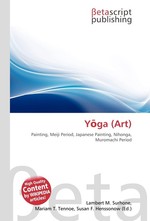Y?ga (Art)
Lambert M. Surhone, Mariam T. Tennoe, Susan F. Henssonow
бумажная книга
Please note that the content of this book primarily consists of articles available from Wikipedia or other free sources online. Yoga or literally "Western-style paintings" is a term used to describe paintings by Japanese artists that have been made in accordance with Western (European) traditional conventions, techniques and materials. The term was coined in the Meiji period, to distinguish such works from indigenous traditional Japanese paintings, or Nihonga. European painting was introduced to Japan during the late Muromachi period along with Christian missionaries. Early religious works by Japanese artists in imitation of works brought by the missionaries can be considered some of the earliest forms of Yoga. However, the policy of national seclusion introduced by the Tokugawa bakufu in the Edo period effectively ended the influence of western art on Japanese painting, with the exception of the use of perspective, which was discovered by Japanese artists in sketches found in European medical and scientific texts imported from the Dutch via Nagasaki. In 1855, the Tokugawa bakufu established the Bansho Shirabesho, a translation and research institute for western studies, including a section to investigate western art.
Данное издание не является оригинальным. Книга печатается по технологии принт-он-деманд после получения заказа.


